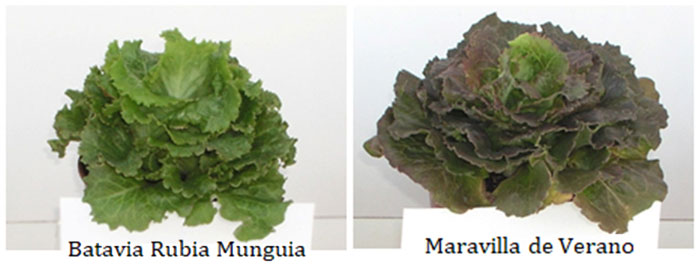| Tweet | Follow @co2science |
Paper Reviewed
Garmendia, I., Bettoni, M.M. and Goicoechea, N. 2020. Assessing growth and antioxidant properties of greenhouse-grown lettuces (Lactuca sativa L.) under different irrigation and carbon fertilization management. Revista De La Facultad De Ciencias Agrarias UNCuyo 52: 87-94.
Introducing their study, Garmendia et al. (2020) write that lettuce (Lactuca sativa) "is one of the most popular vegetables given its healthy properties, attributable to the presence of fiber, antioxidant compounds and minerals," citing the works of Romani et al. (2002), Serafini et al. (2002) and Llorach et al. (2008). Given such prominence in the human diet, it is therefore important to understand how lettuce growth and nutritional properties might be altered under changes in CO2 and climate.
To provide some answers, Garmendia et al. exposed three-week-old lettuce seedlings from two cultivars (see Figure 1) -- Batavia Rubia Munguia (BRM) and Marvilla de Verano (MV) -- to ambient (~400 ppm) or elevated (~700 ppm) CO2 concentrations under either well-watered (field capacity) or water-deficit (two-thirds of field capacity) conditions for seven weeks in a controlled-environment setting. At the end of the treatment period the researchers evaluated cultivar growth and total antioxidant capacity (in the leaves).
Results of the study indicated that elevated CO2 had a modest effect on plant fresh weight under well-watered conditions, inducing a 7% and 8% increase in BRM and MV, respectively. However, under water-deficit conditions, elevated CO2 improved this parameter by a much greater 24% (BRM) and 42% (MV). What is more, elevated CO2 fully ameliorated the negative impact of water deficit conditions on the fresh weight of the two cultivars; fresh weights in the elevated CO2 and water-deficit treatments were 20% higher than that observed in the ambient CO2 and well-watered treatments for both cultivars.
With respect to antioxidant capacity, Garmendia et al. report this measure of nutritive value was "significantly enhanced" in leaves of BRM under elevated CO2, whereas it remained unchanged in the MV cultivar.
In light of all of the above, the authors conclude that "carbon fertilization can enhance yield and/or the antioxidant properties of greenhouse-grown lettuces, but results are highly dependent on the variety or cultivar evaluated." Nevertheless, they note "carbon fertilization and/or moderate water limitations can be strategically used to enhance nutritional value and growth of greenhouse lettuce," which is an important finding given that such lettuce cultivars, in their words, are "extensively cultivated in greenhouses and highly commercialized" in Spain and other countries.

Figure 1. Representative images of the two lettuce cultivars (Batavia Rubia Munguia and Marvilla de Verano) examined in the authors' study.
References
Llorach, R., Martínez-Sánchez, A., Tomás-Barberán, F.A., Gil, M.I. and Ferreres, F. 2008. Characterization of polyphenols and antioxidant properties of five lettuce varieties and escarole. Food Chemistry 108: 1028-1038.
Romani, A., Pinelli, P., Galardi, C., Sani, G., Cimato, A. and Heimler, D. 2002. Polyphenols in greenhouse and open-air-grown lettuce. Food Chemistry 79: 337-342.
Serafini, M., Bugianesi, R., Salucci, M., Azzini, E., Raguzzini, A. and Maiani, G. 2002. Effect of acute ingestion of fresh and stored lettuce (Lactuca sativa) on plasma total antioxidant capacity and antioxidant levels in human subjects. British Journal of Nutrition 88: 615-623.
Posted 4 September 2020



